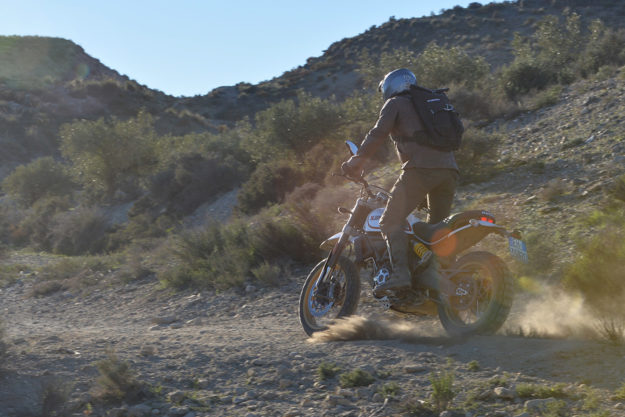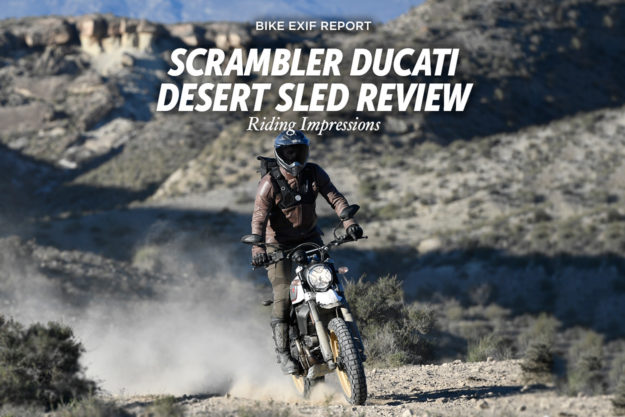
You don’t need to be a regular reader to know that scramblers are hot. Over the last few years, the term has become the go-to marketing moniker for OEMs looking to cash in on the growing moto lifestyle. From a business standpoint it makes complete sense; the carefree attitude exuded by scramblers appeals to millennials and nostalgists alike.
But in their haste to plaster ‘scrambler’ on everything with a high mount exhaust and less than slick rubber, the manufacturers have diluted its meaning.
I’m not taking anything away from the quality of bikes that are laying claim to this category. We’ve ridden and thoroughly enjoyed quite a few of them. But scramblers they are not. At least not in the classic sense.
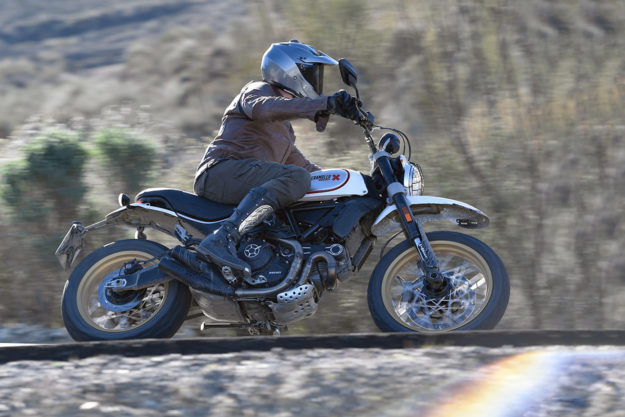
The Scrambler Ducati team has been as guilty as the rest of them. Nothing from the Land of Joy was designed with actual backcountry in mind. But unlike the competition from BMW, Triumph and Yamaha, the Italians are now attempting to make amends.
The new Desert Sled is Ducati’s peace offering to us purists. So I went to the Tabernas Desert—in the province of Almería, southeastern Spain—to see if we finally have the legit scrambler we’ve all been waiting for.
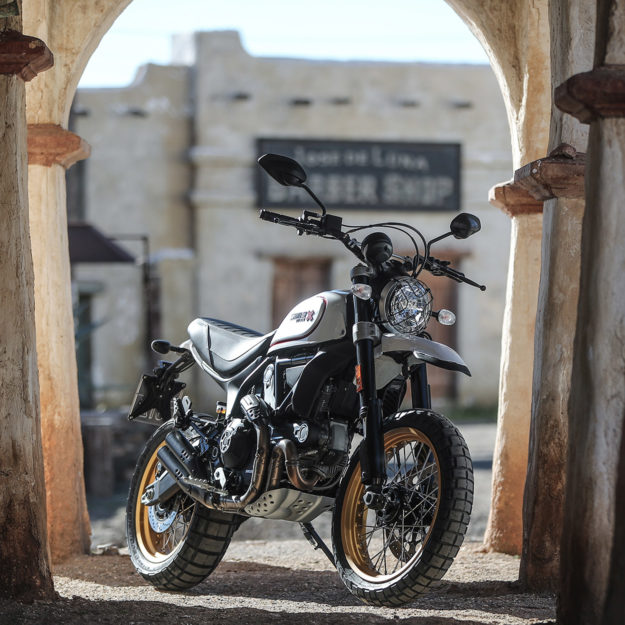
Design According to Ducati, the Desert Sled is the bike they’ve wanted to create since the inception of the Scrambler sub-brand. They claim it’s the natural evolution of the Urban Enduro, and draws clear inspiration from the 1969 Baja-winning 350 Desmo, piloted by Doug Douglas.
Given recent trends, you might conclude that the Desert Sled is just an accessories package bolted to an unchanged chassis. But it’s not. It’s an all-new motorcycle, re-designed from the ground up, and it delivers its badassery in more than just the looks department. In fact, after riding it, I would argue that this is the bike that should have started it all.
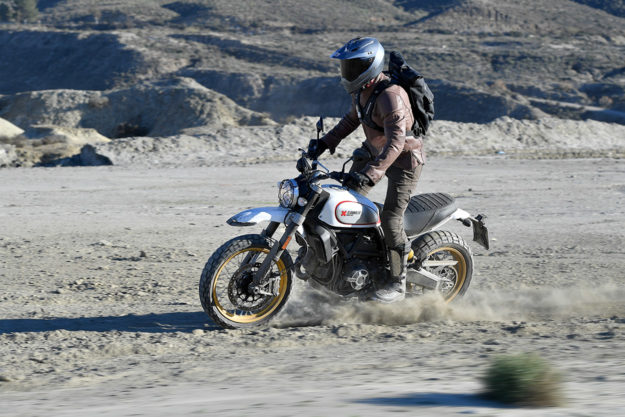
It’s a big bike: it stands taller and looks more aggressive than anything else in the Scrambler Ducati stable. The bars are wide and cross-braced, and the Pirelli Scorpion Rally STR rubber was developed specifically for this bike. Both provide the MX cues, but the teardrop-style tank and the round headlight are closer to the ‘modern classic’ aesthetic.
The 803 cc L-Twin engine also sees duty in the new air-cooled Monster, and is used by all Scrambler models except the Sixty2. But in the Desert Sled it is no longer a stressed member. To handle the rigors of rough conditions, the trellis frame chassis had to be strengthened. Coupled with the other off-road specific parts, they translate to a fairly substantial 46-pound bulk-up: the Desert Sled weighs 456 pounds (206 kilos).
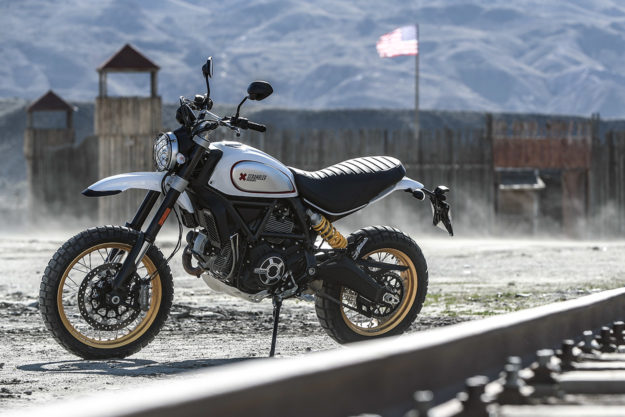
To help offset the weight, the all-new swingarm was fabricated from aluminum. It differs from the standard setup by having a sharper curve that perks up the rear and adds some three inches to the wheelbase. Up front, rake and trail remain the same. The Sled also rides on a gorgeous set of spoked gold rims, with a 19-inch hoop up front and a 17-inch unit in the rear.
The changes create a motorcycle that embraces the off-road capability that turned ‘desert sled’ and ‘scrambler’ into motorcycling household terms. Fit and finish is in keeping with Ducati’s usual standards, and I’m happy to report that nothing has been watered down for the Starbucks parking lot.
It has a brutish stance that will never be confused with the daintiness of a dirt bike, but there are enough MX parts to suggest that this is something special. Check the aggressive, wide knobby rear, the slender waist, the headlight guard and beaked front fender: The Desert Sled does not mask its intentions.
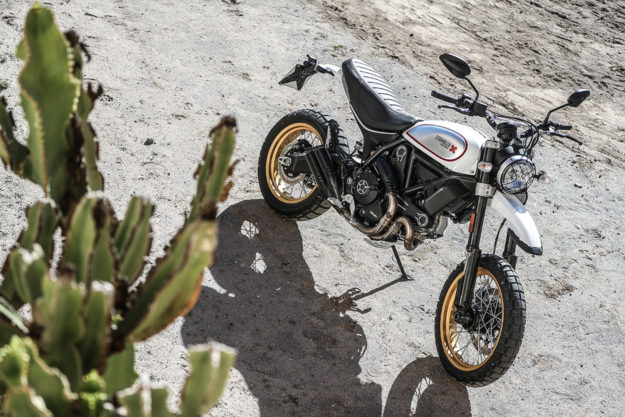
Engine and Vital Stats The Desmodromic L-Twin puts down 75 hp at 8,250 rpm and 50 lbs-ft of torque at 5,250 rpm—plenty motivation to have fun on both tarmac and dirt.
The six-speed transmission is mated to a wet APC clutch and shifts seamlessly, although it hides neutral from time to time. The fuelling felt linear and direct throughout my ride with plenty of roost available at any point it was needed.
Ride height is 9.4 inches and the fully adjustable Kayaba suspension gives 7.9 inches of travel, both front and rear. The front forks are now 46mm USD units, compared to the 41mm cartridge forks found on other Scrambler models.

Ergonomics At 33.9-inches in height, the Desert Sled’s saddle is not sized for shorter riders. That being said, Ducati’s engineers did a great job of shaping the seat to make it comfortable, and it was slim enough for me to stand flat-footed at the lights.
The tapered seat also made it easy to lock my knees on the tank during our off road adventures. At 6 feet tall with a 32-inch inseam, I had no issues whatsoever—although some of the more vertically challenged riders in our group struggled for purchase when the tarmac disappeared.
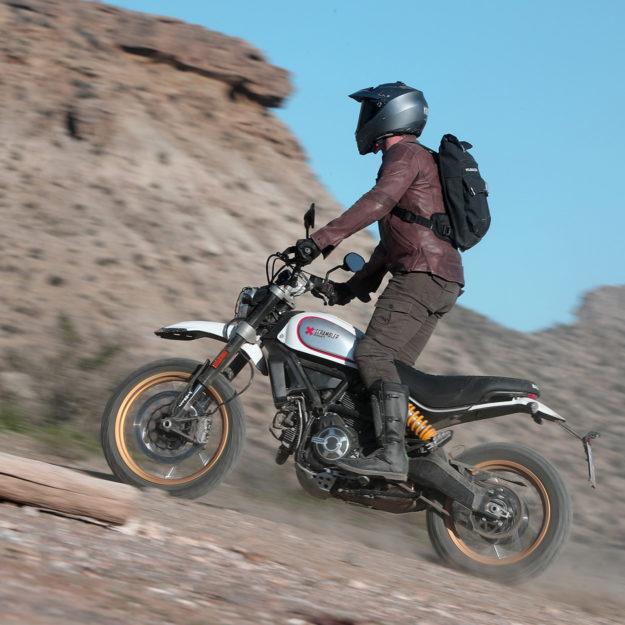
The bars are wide and flat, and other than rotating them a degree or two forward for a better standing grip, there’s little I would change here. The single round digital gauge is a carryover from the other Scrambler models but it does everything you need it to—and it’s easily visible in variable conditions. Personally, I’d like to see a gear indicator and possibly a different tach display, but those gripes are purely subjective.
The pegs are well placed, allowing easy transitions from seated to standing. They sit high enough and only sparked once in the twisties. My bike was equipped with optional bear-trap style pegs, due to the technical nature of the off-road course, but the standard set sit at the same height and have removable rubbers to help absorb vibrations. They add comfort during relaxed riding stints, but this isn’t exactly a touring machine.
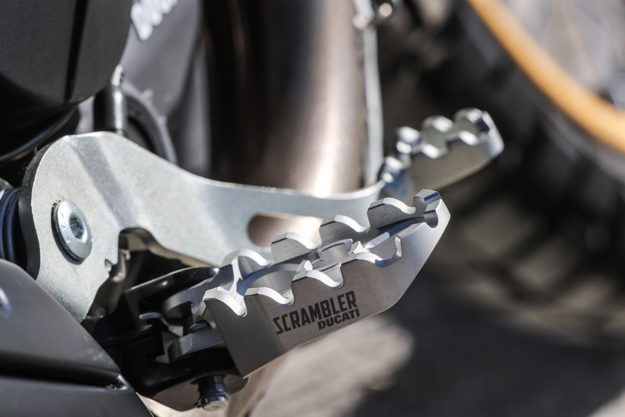
The Ride It’s not often that a bike exceeds my expectations, but this one definitely did. I’d sussed out that it could hold its own in the dirt in the hands of a pro, but I didn’t think it’d fare so well for me.
Our ride began with a very technical negotiation of about six kilometers of fresh sand wash. It was the kind of terrain that should have chewed up the big Duc, and spat us both out in a cloud of dust; the kind of terrain Ducati accountants have nightmares about. I won’t say it was easy, but with enough speed and commitment the fat front tire found some float, and I could bomb through the mush.
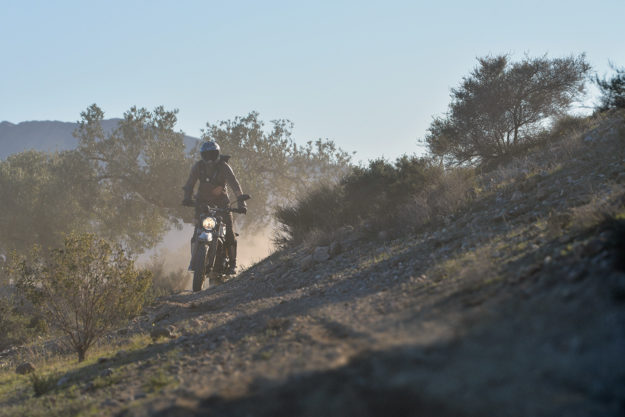
With a bike this heavy (and an engine this torquey), less-than-delicate throttle modulation can quickly end your fun. On our second time through the deep stuff, heading back for lunch, it was infinitely tougher to stay upright. The sand had been churned with cross-ruts everywhere, and many riders were moving at a slower pace.
Plodding along caused the front end to plow, and I could feel the Sled’s heft trying to bury us both. And I soon experienced how hard it can be to right the beast when it starts to get away: It takes some serious effort and some well-timed dabs, but it can be done.
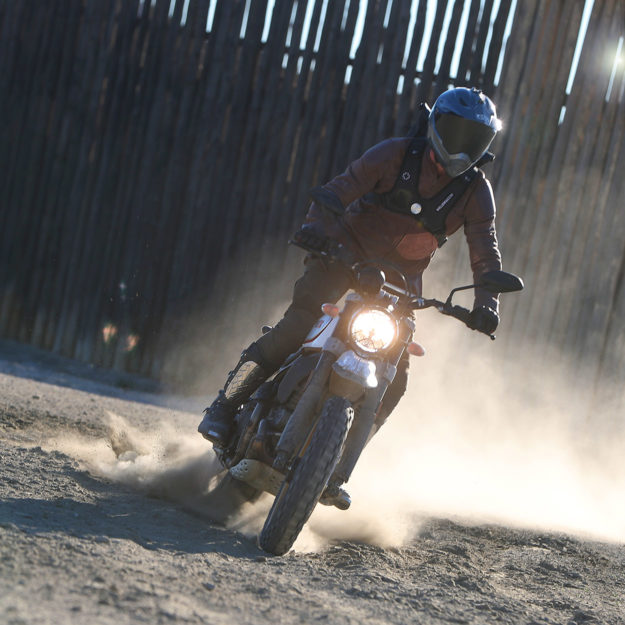
In the interests of filing a comprehensive report, I also examined how easy it is to wake up the Duc up after it decides to take a nap. Twice. A thinner front tire might help matters, but I honestly doubt it’d be worth the trouble. In the hands of faster and more experienced off-roaders there was less drama, but all agreed that deep sand isn’t the terrain you should be searching out on this beast.
Once out of the soft stuff though, the Sled hauls ass with the best of them. It’s comfortable and responsive in a standing position, and made short work of the two-track trails running around Fort Bravo.
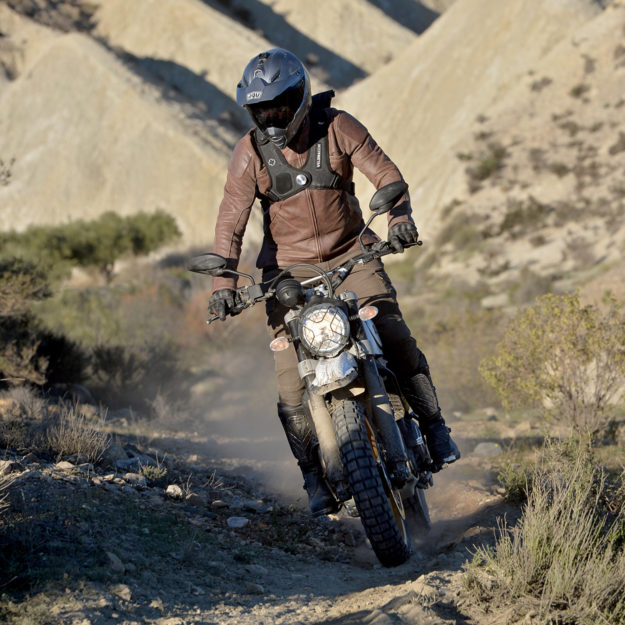
I was surprised by how natural the bike felt between my knees and when steering with the pegs. And thanks to that grunty twin, you can keep the bike up a gear and simply lug through the tight spots, or twist up a cloud of roost whenever you want.
The fully adjustable forks and the remote reservoir single shock were set up stiffly for the road, but weren’t punishing at all. And they dealt with some impressive rocks and ruts without crunching anything important, or shaking my internals loose.
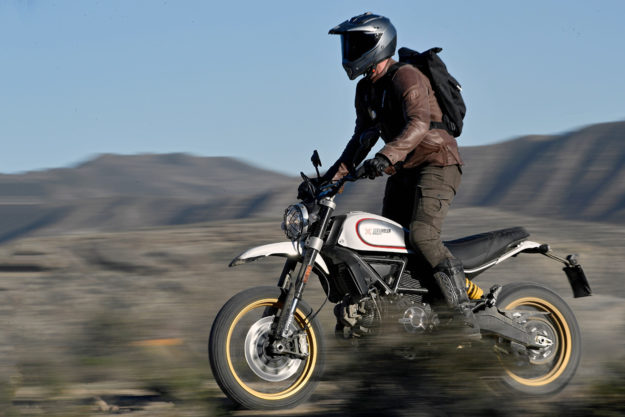
If weekend jaunts along fire roads and logging routes are what you do, the Desert Sled can hack it better than it should. And if you find rougher terrain, feel free to head off and explore. Surprisingly, she can handle it.
Getting to those off-piste points is a blast too. On the road, the Desert Sled is limited only by how off-putting you find the squirming Pirellis. It isn’t knee-dragging rubber, but once I got used to it, I had no reservations about adding speed in the corners of Almería’s winding Route 102.
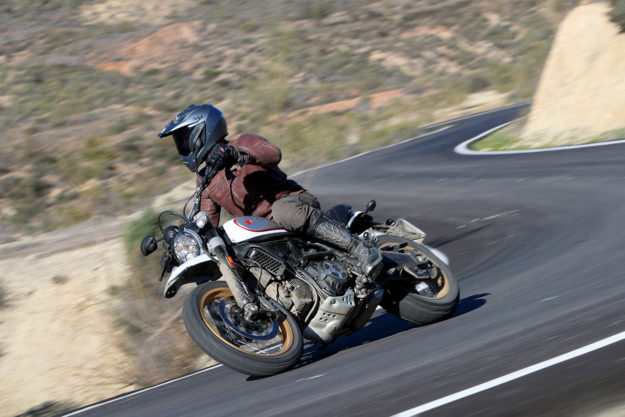
From a seated position the bars were spot on for my reach. Even with the 19-inch front wheel, the Sled needed only a mild suggestion to initiate lean-in, and felt confident and planted through every corner we clipped.
The suspension came into its own on the broken sections of winding asphalt leading up through Níjar. The front forks easily smoothed out bumps that would send a sport bike into panic mode, without feeling floaty at any point. All the while, the rear was planted and predictable. The extra ride height also stops pegs from grinding most of the time.
The brakes are single disc four-piston Brembos up front and a single-piston unit in the rear, and they easily kept the Sled reigned in. They were easy to modulate and never felt vague or abrupt. ABS is standard but I never bothered to turn mine back on, so apologies on that score—I can’t report on how intrusive it may be.
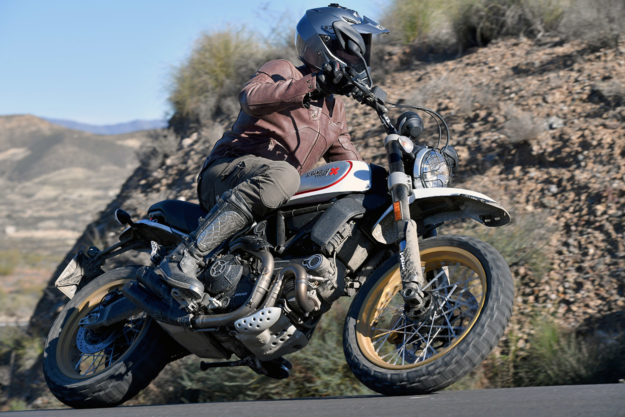
Customizing As soon as the Sleds were back at base and resting on their kickstands, I started to look at where improvements could be made. There was an accessory-equipped model sitting in the ‘Texas Hollywood Saloon’ at Fort Bravo—a Western-styled theme park built in the 1970s—and it definitely had some niceties.
First off, the stock exhaust would have to go. Not that it’s particularly bad, but the optional Termignoni high-mount unit looks incredible. And would make the sound on overrun that much sweeter.
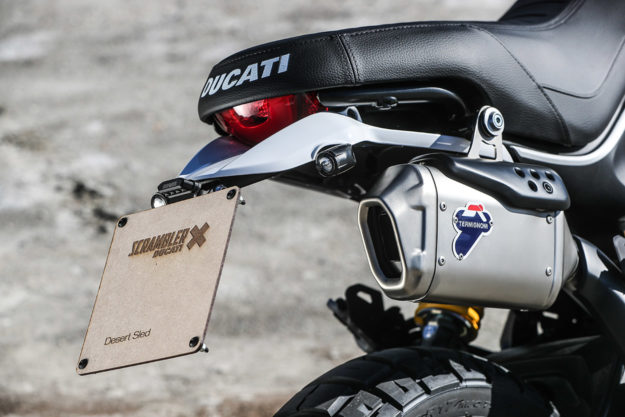
An extra set of bash guards is available, as well as a branded oil cooler shield. If your plan is to abuse this machine—and I hope it is—these would go a long way to saving cash further down the line.
In the looks department there’s a trick set of LED turn signals. These declutter both ends of the bike and, as a bonus, they sit well out of the way should you ever lay the Sled down.
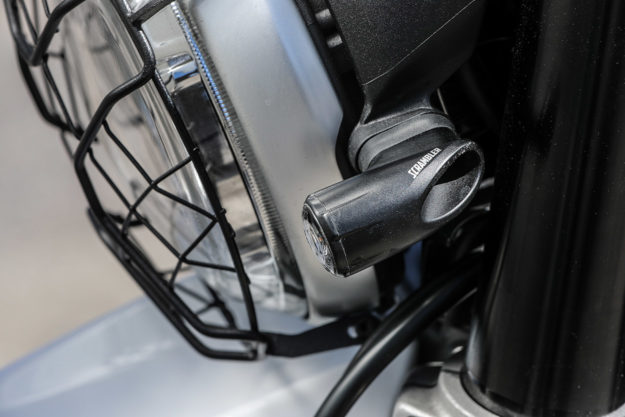
In time, the aftermarket will offer up more options. I’d wager that a few boxes from Fox Shox would make this thing even better in the sand, and the chance to shave off a few pounds would be appreciated too.
So there you have it. The Land of Joy has expanded. Ducati’s World of the Scrambler is no longer a topography coated by the sheen of fresh tarmac. The asphalt has cracks. There are dusty paths connecting destinations, as well as berms and jumps along the way. It even includes rutted two-track, and kitty litter deep enough for a Lion to use.
If scrambling is your thing—and your taste is for modern classics—we’ve found your bike. The Desert Sled is the scrambliest scrambler money can buy.
Scrambler Ducati Desert Sled | Facebook | Instagram
The Desert Sled retails for $11,395 for the Dusk Red model. Should you want the White Mirage colorway—which is arguably the prettier of the two—it will cost an extra $200.
